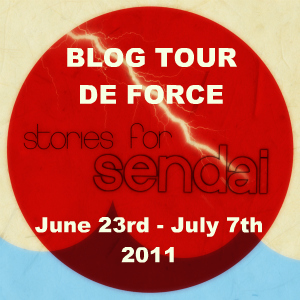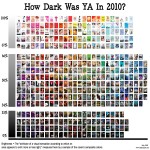When I heard about J.C. Martin was publishing an anthology of short stories to help the victims of the earthquake and tsunami in Japan, I knew I was looking at something special. Some of you may remember J.C. Martin as one of the DIY MFA TAs, and together with her co-editor Michelle Davidson Argyle, she’s put together a fabulous collection of stories. To purchase your copy, go here. For more information about STORIES FOR SENDAI, visit the website.
Today J.C. shares some insider secrets on how to get an editor’s attention. She gives some great tips on how to increase your chances of getting your work noticed, all based on her experiences putting together this anthology. Thank you J.C and Michelle for including iggi&gabi on your blog tour! And now, without further ado, here’s J.C.
How to Up Your Submission’s Chances of Getting Accepted
We’re really excited to be here on Iggi & Gabi’s blog on the release day of our charity anthology, Stories for Sendai! We are hoping to raise as much as we can to help the victims of the earthquake and tsunami in Japan, so why not purchase a copy of the anthology today to help boost Stories for Sendai’s rankings in the Amazon charts, and to further increase our exposure?
Gabi suggested that people may be interested in learning about the editorial aspect of compiling the anthology, predominantly the process of selection: how did we pick our accepted entries? What did we look for? What didn’t we like? It occurred to us that this information might be useful for anyone considering submitting their work to magazines and anthologies, so we were more than happy to share what we know!
Selecting the entries was probably the hardest part of the whole project! We received so many fantastic stories and poems, we were forced to be ruthless with our choices, picking only the best of the best. What a challenge that was! But every entry that went straight into the ‘yes’ pile will have satisfied most (if not all) of the following criteria:
The story fits the required theme. Apart from the obvious aim: to raise money in aid of victims of the March earthquake and tsunami in Japan, we also wanted the stories in this anthology to be morally uplifting, to reflect the quiet strength and tenacity of the Japanese people in the face of overwhelming odds and adversity. As such, all selected entries for the anthology have one thing in common: apart from the fact that they are all awesome, each one is themed around hope, survival, and the strength of the human spirit.
That was a theme we stipulated in our submission guidelines: we wanted stories that left us with a warm fuzzy feeling, or a tear in our eye. However, you’d be surprised at how many entries we received that clearly did not fit the theme, or had the theme jackhammered into what is obviously not a piece of work written specifically for the anthology, but something that had been sitting in the writer’s drawer or computer folder for ages, that they decided to dust off and send in. It is annoying to receive entries like that, as it wastes both the editor’s time and yours.
The story is surprising. We’re big fans of the surprise ending. It’s a skill to be able to include a plot twist within the confines of a short story. Predictable storylines lull us into ‘skim-read’ mode—we already know the ending, so quit the preamble already! Endings with a “Woah, I didn’t see that coming!” factor will always grab the editor’s attention!
The story is unique. The beauty with short stories is that you can write just about anything, so go on—surprise us! Because of our stipulated theme, we received a load of entries about people living with terminal diseases—not only were they depressing, they’re cliché. Editors like it when writers think outside the conventional box. Wow us with something different!
If your story isn’t unique, you’ll need to pull out all the stops to impress us—beautiful prose, flawless writing, and something unexpected—yes, if you’re telling an old story, make sure you do it in a new and unique way!
The story is believable. Even fantasy stories about other realms must have a touch of realism to it. If we start thinking “That character wouldn’t do that!” or “Isn’t that a convenient coincidence!”, then there are inconsistencies in the story that has to be addressed.
The story is well written. Every writer will eventually develop their own writing style and voice. This can only come with practice. There is no use trying to write in the style of Ernest Hemingway when you’re a Stephen King; your prose will end up looking forced. Good writing, be it a lyrical piece of literary fiction, or short, simple prose in a commercial work, will flow well, effortlessly displaying the writer’s true voice.
Just remember: there is a fine line between amateurish writing and purple prose.
The story is proofread. Basic errors in SPG (spelling, punctuation and grammar) pees us off. A glaring typo jars us from the story, and awkward punctuation and sentence structures will prevent readers from completely immersing themselves into your story. Additionally, it smacks of unprofessionalism and laziness: if you can’t be bothered to make sure your work is as polished as it can be before submitting it, why should we give you the time of day?
The story is formatted according to our submission guidelines. We have been kinda lax with this, but it does rub some editors up the wrong way if they specifically asked for Times New Roman and you send in a piece of work entirely in Comic Sans. Correct formatting just makes life much easier for us in the publication stages, when we sort out the format and layout of the entire book. It may sound harsh that your work might be rejected just because it’s a bit too much work to format correctly, so play it safe and give the editors what they asked for.
And finally…
The story ‘feels right.’ If a story has satisfied all the above criteria, what really sells it for us is that feeling in our gut that tells us that this story is something special. It may be subjective, and sometimes entries can be like Marmite: you either hate it or love it, but we know we’re on to a winner when a story resonates with us!
Well, that’s it! We hope you found this information useful, and good luck with all your future submissions!
For an extra edge, why not try and win a critique of your short story, first chapter, query or synopsis? Just purchase a copy of Stories for Sendai and email us a copy of your receipt to be entered for the draw! Not only could you win a prize, you’ll get a lovely book of wonderful stories, and you’ll be helping the people of Sendai! Visit the Stories for Sendai website for more details of the contest!







 Call me Gabi (pronounced gah-BEE). I'm a writer, freelance teacher, and a lover of books and words. I'm also the instigator of DIY MFA. iggi's my sidekick, but he thinks he's the brains behind this operation.
Call me Gabi (pronounced gah-BEE). I'm a writer, freelance teacher, and a lover of books and words. I'm also the instigator of DIY MFA. iggi's my sidekick, but he thinks he's the brains behind this operation.
 Goodbye is for Sissies
Goodbye is for Sissies YA Cafe: What YA Book are You Thankful For?
YA Cafe: What YA Book are You Thankful For? YA Cafe: Why I Love Dark YA
YA Cafe: Why I Love Dark YA YA Cafe: YA Appreciation Month
YA Cafe: YA Appreciation Month
Comments on this post
Thank you for having me! I’ve really enjoyed the blog tour so far, and I really enjoyed writing this particular post! Hopefully it’ll be of use to some people. 🙂
30. June - 5:29 pmSuccinct, spot-on advice from someone who knows. Doesn’t get much better than that!
30. June - 5:48 pm